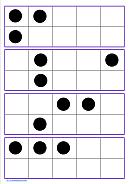Irons (1999) suggested that the best way to introduce mathematics to young children is by establishing the mathematical concepts through “learning experiences”. These learning experiences should encourage children to use language to describe and interpret meaning by interacting with the environment. The learning experiences can also be described as “processes” and is the most important factor that sets the foundation for mathematics. Teaching the beginning processes in mathematics is essential to ensure young learners have a good grasp of basics in mathematics. Learners will be able to interpret and comprehend the integral part of mathematics through the activities that requires the use of senses.
Identifying and describing attributes
This is a “process of highlighting and explaining attributes in relation to their similarities or differences” (Irons, 1999, p. 27). Teacher should encourage children to use wide range of language as it will help to promote reasoning at a very young age. For example, children may be playing with two toy cars that are same is shapes and size but different in colours. Teachers should encourage them to use their senses and identify the differences between the two trucks and use language to talk about it as they play.


Matching activities focuses on the “sameness of attributes” (Irons, 1999, p.27). Children will have to arrange objects according to the objects’ attributes like colour, shapes, number of objects and size of the objects. During this activity, it is important for teachers to ask questions like ‘Why does this match?’ to extend children’s thinking and reasoning. This type of questioning may help to lower the “affective filter” of the young learners and motivate them to participate actively in classroom (Krashen, 1982, p.64).
Irons (1999) defines sorting as a process involving matching, but with a greater number of objects”. The process of sorting involves grouping objects or pictures according to one or more attributes. For this activity, teachers can plan for the children to sort things by one attribute first and later proceed to a more difficult activity, which is sorting by two or more attribute. Teacher scaffold also plays an important role here as it helps the children to reach a stage of development that will prepare them for more complicated tasks (Vygotsky, 1964 in Berk, 2009).
Children will be comparing based on the amount of one attribute that is possessed by two objects (Irons, 1999). Children are required to determine which object has more or less of the attributes and use language to compare the two objects. Their vocabulary can be highly developed during this process as their vocabulary bank can be expended when they are younger (Jenkins, 2003). The teacher needs to address that comparison is relative and it may change or have more than one relationship so that children can understand that comparison is relative and not rigid within a context only.
Ordering
The process of ordering involves “arranging objects, pictures, groups, or events according to the relations between them based in increasing or decreasing amounts of an attribute” (Irons, 1999, p. 30). According to Berk (2009), it is vital for teachers to use real world objects and experience during this process as learners that learners can connect with outside their classrooms. This can be further supported by Irons (1999) who claims that young children learn best when their learning experiences involves their real life experiences because they can see a purpose of learning. Basically, children need to be able to identify, describe attributes, detect differences and make comparisons in order to do ordering.
“Patterns are formed by the repetition of objects or pictures, and are recognizable and predictable” (Irons, 1999, p. 31). In general, there are three types of patterns:
Patterning forces children to draw on skills such as observing, analysing and predicting. As stated by Irons (1999) “patterning activities help children develop confidence when they are faced with problems to solve” (p.31).
All these beginning processes provide a solid basis for children to “decipher” and understand the world which they live in. Teachers should design and plan interesting activities that will expose the children to mathematics and give them the opportunity to develop their potentials to learn and enjoy mathematics.
~~~~~~~~~~~~~~~~~~~~~~~~~~~~~~~~~~~~~~~~~~~~~~~~~~~~~
Berk, L.E. (2009). Child Development (8th Ed). United States of America: Pearson Education.
Irons, R. R. (1999). Numeracy in early childhood educating young children. Learning and Teaching in the Early Childhood Years, 5 (3), 26-32. Retrieved from Queensland University of Technology Course Materials Database.
Jenkins, J. (2003). World Englishes. New York: Routledge Taylor & Francis Group.
Krashen, S. (1982). Second language acquisition and second language learning. New York: Pergamon Press.





































